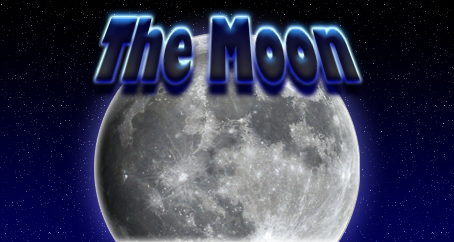The Apollo Missions
Part Two - Apollo 11 to Apollo 17
It was the summer of 1969 and American scientists were ready to send the first man to the Moon. This was a goal set only seven years earlier by President John F. Kennedy in 1962. Kennedy was assassinated the year after announcing his decision, but his plan still went ahead and between 1962 and 1969, NASA carried out several test missions to prepare themselves for the eventual Moon landing. Despite a disastrous start to the Apollo program when a fire broke out in the Apollo 1 Command Module during a pre-launch test, the program continued with four unmanned missions (Apollo 4, 5, 6 and 7) and three manned missions (Apollo 8, 9 and 10). Apollo 10 was the final rehearsal, doing everything apart from the Moon landing itself. This honour would go to the crew of Apollo 11, to be launched in July 1969.
The Eagle has Landed - Apollo 11
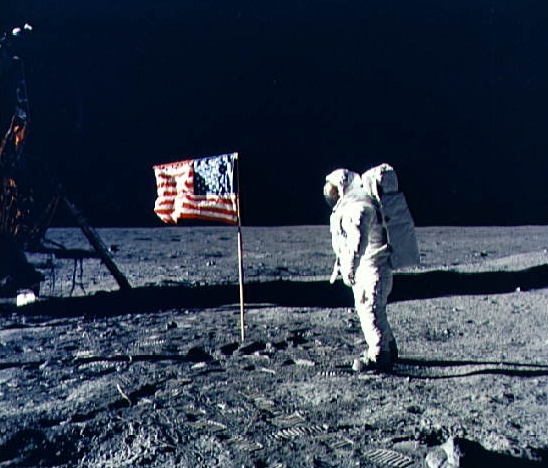
Apollo 11 was launched from the Kennedy Space Center in Florida on 16th July 1969 using a Saturn V rocket. Inside the Command Module of the spacecraft were three astronauts: Neil Armstrong, Edwin "Buzz" Aldrin and Michael Collins. Apollo 11 took three days to reach the Moon. Once in Lunar Orbit, Neil Armstrong and Buzz Aldrin left the Command Module (known as Columbia) and entered the Lunar Module (known as Eagle). Michael Collins remained in the Command Module in orbit around the Moon. About six hours after entering the Lunar Module, it was separated from the Command Module and began its descent to the surface of the Moon. Neil Armstrong took up manual control of the Lunar Module after noticing that the site that the Lunar Module's onboard computer was taking them too was too rocky. Despite communication problems, computer overloads and rapidly decreasing fuel, Neil Armstrong successfully landed on the Moon's surface with 30 seconds of fuel remaining, announcing that "the Eagle has landed." At 2.56am UTC on 21st July 1969 (10.56pm EDT on 20th July 1969), six and a half hours after landing, Neil Armstrong climbed down the ladder attached to the Lunar Module and took the first footsteps on the Moon, saying the famous words, "This is one small step for (a) man, one giant leap for mankind." The event was captured by a television camera which was attached to the side of the Lunar Module. Neil Armstrong released the camera and activated it while climbing down the ladder to the surface of the Moon. The black and white images from the surface of the Moon were immediately beamed back to Earth and over 600 million people watched as Armstrong took his first steps on the Moon. Neil Armstrong was shortly joined on the Moon by Buzz Aldrin. During their time on the Moon, the two astronauts collected samples of soil and rocks, planted an American flag, set up scientific experiments, took a phone call from US President Richard Nixon and took lots of pictures. Walking on the Moon wasn't as difficult as some imagined, although the thin powdery soil meant that it could be slippery. After two and a half hours on the Moon, Armstrong and Aldrin returned to the Lunar Module. They left their life support backpacks, lunar overshoes, a camera and some other objects on the surface of the Moon to lighten the weight of the Lunar Module for its ascent back to the Command Module. After resting for seven hours, Neil Armstrong and Buzz Aldrin were instructed to leave the Moon. The force of the lift-off blast is thought to have blown over the American flag left on the Moon (in later missions, the US flag was planted 100 feet away from the Lunar Module to prevent it from happening again). Also left on the Moon was the Lunar Module's landing platform, with a plaque attached to it displaying two images of Earth, signatures of the Apollo 11 astronauts and Richard Nixon (his signature, not Richard Nixon himself!), and an inscription saying, "Here Men From The Planet Earth First Set Foot Upon the Moon, July 1969 A.D. We Came in Peace For All Mankind." The Lunar Module redocked with the Command Module and Neil Armstrong and Buzz Aldrin rejoined Michael Collins to tell him all about their day out on the Moon! The Lunar Module, Eagle, was jettisoned shortly afterwards and entered Lunar orbit. It is believed that is has since dropped out of this orbit and now lies somewhere on the surface of the Moon. The Command Module continued with its journey back to take the three astronauts back home and splashed down on Earth on 24th July 1969 at 4.51pm UTC (12.51pm EDT). They were recovered shortly afterwards, completing what is often seen as the most successful and trouble-free space mission to date.
Back to the Moon - Apollo 12
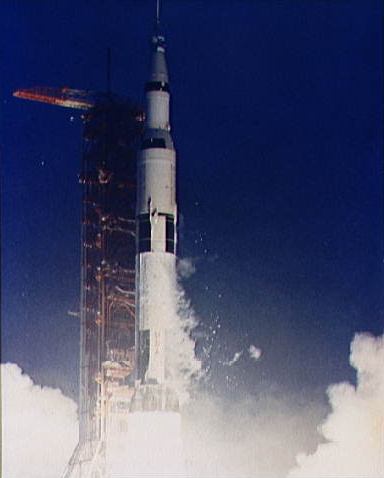
So, after the success of Apollo 11, what next? Yep, go back to the Moon! Apollo 12 launched from the Kennedy Space Center less than four months after Apollo 11 on 14th November 1969. Pete Conrad, Richard Gordon and Alan Bean were the astronauts on board. The mission came close to being aborted shortly after launching after the Saturn V rocket was struck by lightening. This caused the possibility of inaccurate information about the spacecraft being transmitted to ground control. This problem was soon solved after Alan Bean recalled a training exercise where the same situation was simulated a year earlier and got everything back to how they should be. The journey to the Moon ran smoothly and on 19th November, while in lunar orbit, the Lunar Module (Intrepid) undocked from the Command Module (Yankee Clipper). Pete Conrad and Alan Bean were the two astronauts in the Lunar Module while Richard Gordon remained in the Command Module. The landing was controlled mostly by computer, and the Lunar Module landed just about exactly where planned. Two years earlier, the probe Surveyor 3 had landed on the Moon, and NASA wanted Apollo 12 to be a mission testing precision targeting, deciding to attempt to land it in the same landing site as Surveyor 3. Apollo 12 landed only 200 metres away from Surveyor 3, meaning the astronauts were able to visit the probe and took pieces of it back to Earth for analysis. Television transmission of the mission ended shortly after landing after Alan Bean accidentally pointed the colour camera directly at the Sun which stopped it from working! Bean and Conrad spent just under eight hours on the Moon, making two moonwalks of almost four hours each. They left the Moon, again leaving scientific equipment, a flag, the landing platform and a plaque and returned to the Command Module. Splashdown on Earth occurred at 8.58pm UTC (3.58pm EST) on 24th November 1969.
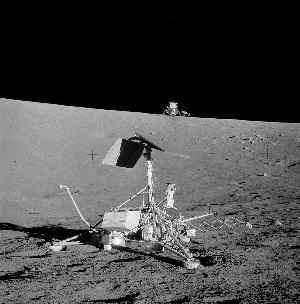
A Successful Failure - Apollo 13
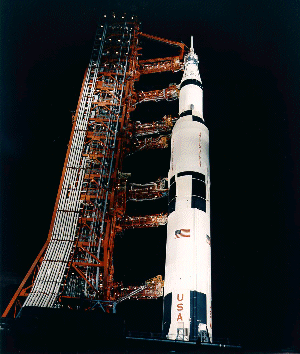
By the end of the decade, America had achieved its goal of landing a man on the Moon and returning him home safely, and did it again just to prove that the first landing was no fluke. As they went into the 1970s, NASA planned further missions to the Moon. To some, the Apollo program was already becoming almost routine and many thought it was a waste of resources. A lot of people saw the main aim of Apollo as being to beat the Russians to the Moon. Now this had been achieved, there seemed little point in going back there. Apollo 13 was planned to be the third Moon landing, but interest in the mission was so low that a television broadcast made from the Command Module while on its way to the Moon failed to get shown by any of the American television networks. Jim Lovell, John Swigert and Fred Haise were the astronauts on board Apollo 13, the ill-fated craft that launched from Kennedy Space Center on 11th April 1970. Shortly after launch, one of the engines shut down early, but mission control gave the go-ahead for the mission to continue using the four remaining engines. Two days later, at just under 200,000 miles away from Earth, one of the two oxygen tanks contained in the Service Module exploded. This occurred after a routine instruction from Mission Control was given to stir the oxygen in the tanks. The explosion blew off one side of the Service Module and left the craft with a limited supply of power and oxygen. The crew would have enough power in the Command Module for re-entry but not enough to complete the objective to land on the Moon or even to support them for much longer while in space. The aim now was to get the astronauts back to Earth as soon as possible. To save power while in space, the Command Module was powered down and the astronauts used the Lunar Module as a "lifeboat". They were unable to turn the craft around so had to use the gravity of the Moon to slingshot themselves back to Earth. This procedure is known as a free return trajectory and would involve going around the far side of the Moon. This idea worked, and on their way back, the astronauts performed a course correction to allow them to return to Earth at the correct angle. Another problem was the depleting supply of breathable air. The Lunar Module was only designed to support two astronauts for two days seeing as it would usually only be used for the descent to the Moon and back to the Command Module. Instead, there were three astronauts in it, and they needed enough air to survive for four days. As the astronauts breathed in the oxygen, they breathed out poisonous carbon dioxide. Too much carbon dioxide would cause the astronauts to suffocate. Canisters containing the chemicals needed to absorb the carbon dioxide and turn it into oxygen were getting empty. There were spare ones in the Command Module, but these weren't designed to fit in the Lunar Module's receptacle. An adapter had to be built using equipment on board the spacecraft to get the Command Module air canisters to fit in the Lunar Module. This idea worked and the astronauts were able to survive on the air in the Lunar Module. There were other difficulties including extreme cold and the fact that, because the Command Module had been without power for days, condensation had built up and it was possible that the water in the condensation would cause an electronic failure when it was powered back up. Fortunately, the Command Module powered up correctly, and after jettisoning the Lunar Module and the Service Module, the three astronauts now in the Command Module were able to return to Earth, splashing down successfully on 17th April 1970. Apollo 13 didn't achieve its aim to land on the Moon, but is sometimes seen as a more technological achievement than any of the other missions - a "successful failure" - requiring ingenuity and knowledge of the capabilities and limitations of the spacecraft to save the lives of the crew onboard. The three astronauts onboard never flew in space again.
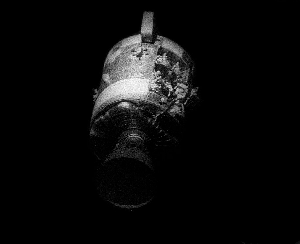
The Unmanned Apollo Missions - Apollo 4, 5 and 6
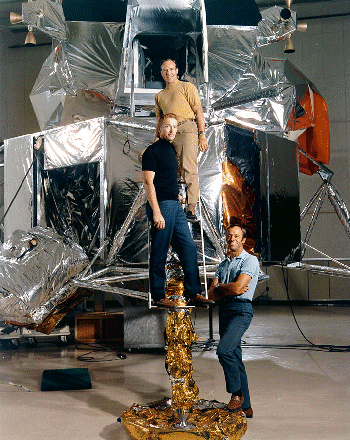
Apollo 13's failure meant that no other lunar mission took place in 1970. Apollo 14 was launched on 31st January 1971 containing Alan Shepard, Stuart Roosa and Edgar Mitchell (pictured left from bottom to top). Despite problems involving the Lunar Module (Antares) not docking easily with the Command Module (Kitty Hawk) on the way to the Moon, the Lunar Module almost automatically aborting the landing while descending to the Moon, and then the Lunar Module not locking onto a landing site on the Moon, Apollo 14 successfully landed and Alan Shepard and Edgar Mitchell became the fifth and sixth people to walk on the Moon. Shepard smuggled a golf club and two golf balls into the space craft and became the first person to play golf on the Moon! The balls actually travelled about 180 to 365 metres (between 200 and 400 yards). The first colour television broadcast from the Moon also took place during Apollo 14. After spending a total of 9 hours and 22 minutes walking on the Moon (split over two moonwalks), the Lunar Module again returned to the Command Module and the crew splashed down on Earth on 9th February 1971.
Apollo 15 was launched on 27th July 1971. The astronauts were David Scott, Alfred Worden and James Irwin. Because of budget cuts, the objectives for Apollo 15 were plans for a later cancelled Apollo mission (Apollo 18) and the original plans for Apollo 15 were scrapped. This meant that the new Apollo 15 flight would be a more science-based mission than the previous Moon landings with more time spent doing things on the Moon. The Lunar Module remained on the Moon for almost three days with astronauts conducting geological experiments for over 18 hours of activity outside the Lunar Module. David Scott and James Irwin were the two astronauts to walk on the Moon, but they were accompanied by the Lunar Rover, a vehicle which allowed them to drive on the Moon and travel greater distances away from their Lunar Module base. After completing their experiments, the astronauts returned to the Command Module and travelled back to Earth, splashing down on 7th August 1971.
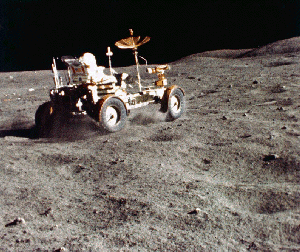
Apollo 16, crewed by John W. Young, Thomas K Mattingly and Charles Duke Jr, launched on 16th April 1972. Mattingly was previously due to fly on Apollo 13, but was dropped two days before launch after being exposed to measles. The mission was similar to Apollo 15 in that it would be a science-based mission spread over three days on the Moon. Young and Duke were the astronauts who walked on the Moon, again accompanied by a Lunar Rover (pictured right). During the Apollo 16 mission, the Lunar Rover achieved the highest speeds for a wheeled vehicle on the Moon, getting up to a maximum speed of 11 miles an hour, a record still held to this day (then again, with only one mission after Apollo 16, there hasn't been much chance to break it!). After over 20 hours of activity on the Moon outside the Lunar Module, Young and Duke returned to the Command Module, and splashed down on Earth on 27th April.
The final trip to the Moon - Apollo 17
Apollo 17 was the final mission to the Moon. Eugene Cernan, Ron Evans and Harrison "Jack" Schmitt were the astronauts on board. The spacecraft was launched on the morning of 7th December 1972 (just after midnight in Florida), making it the first and only night launch of the Apollo program. Schmitt was the only qualified scientist to land on the Moon. In previous missions, although geological experiments had been carried out, they had been done by astronauts, usually from an Air Force or Navy background, whose expertise was in flying and landing spacecraft rather than examining rocks. Schmitt was accompanied by Cernan on the Moon, and together they set the record for the most time spent on the surface of the Moon (they were on the Moon, out of the Lunar Module, for just over 22 hours). Although NASA had originally made plans for Apollo missions up to Apollo 20, the Apollo 18, 19 and 20 missions were cancelled two years earlier. Therefore, knowing that Apollo 17 would be the final mission to the Moon for some years, the plaque left on the Moon read, "Here Man completed his first explorations of the moon. December 1972 AD. May the spirit of peace in which we came be reflected in the lives of all mankind." Eugene Cernan was the last Man to stand on the surface of the Moon and said the following words before re-entering the Lunar Module (Challenger) to return to the Command Module (America): "As I take man's last step from the surface, back home for some time to come — but we believe not too long into the future — I'd like to just [say] what I believe history will record — that America's challenge of today has forged man's destiny of tomorrow. And, as we leave the Moon at Taurus-Littrow, we leave as we came and, God willing, as we shall return, with peace and hope for all mankind. Godspeed the crew of Apollo 17."
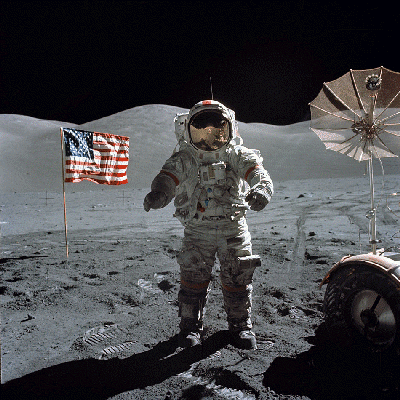
The Apollo program was an extremely successful series of missions, accomplishing President Kennedy's goal of getting a Man to the Moon and back before the end of the decade. Some may have seen the original reason for going to the Moon as being more for political gain than scientific, and after the first two Moon landings, there was a decline in interest in future missions. A belief held by many was that going to the Moon was a waste of money and resources, better spent on issues on Earth. And so, when Apollo 17 left the surface of the Moon, it ended man's exploration of Earth's nearest neighbour. Even to this day, nobody since Eugene Cernan has walked on the surface of the Moon. However, plans are now finally being made to return to the Moon by the end of the next decade, with NASA hoping to set up a permanent base there by the year 2020. With the next big step for mankind being to walk on Mars, it is important that we reacquaint ourselves with the Moon first. Apollo was a huge milestone in manned space exploration - but it was just the beginning!
| Mission | Launch date, Time (UTC) and Launch pad | Crew | Backup Crew | Mission Summary | Splashdown date and time |
|---|---|---|---|---|---|
| Apollo 1 | 21st February 1967 (planned launch) | Command Pilot: Virgil Grissom Senior Pilot: Ed White Pilot: Roger B. Chafee |
April-December 1966: Command Pilot: James McDivott Senior Pilot: David Scott Pilot: Rusty Schweickart December 1966-January 1967 Command Pilot: Walter Schirra Senior Pilot: Donn Eisele Pilot: Walter Cunningham |
First manned mission of an Apollo spacecraft in orbit. A fire in the Command Module during a pre-launch training exercise claimed the lives of all three crew on 27th January 1967. | Planned to land on 7th March 1967 in the Atlantic Ocean north of Puerto Rico. |
| Apollo 4 | 9th November 1967, 12.00:01 Kennedy Space Center, Pad 39A | Unmanned | Unmanned | First launch of Saturn V rocket, an "all-up" mission testing each component of the rocket in one mission. | 9th November 1967, 20.37:00 (estimated) |
| Apollo 5 | 22nd January 1968, 22.48:09, Kennedy Space Center, 37B | Unmanned | Unmanned | First test of the Lunar Module in Earth orbit including a "Fire in the hole" test, simulating an aborted Lunar Module mission. | 23rd January 1968, 09.58:00 (estimated) |
| Apollo 6 | 4th April 1968, 12.00:01, 39A | Unmanned | Unmanned | Final unmanned test, suffered problems shortly after launch | 4th April 1968, 21.57:21 |
| Apollo 7 | 11th October 1968, 15.02:45, Cape Canaveral Air Force Station, Pad 34A | Commander: Wally Shirra CM Pilot: Donn Eisele LM Pilot: Walter Cunningham |
Commander: Tom Stafford CM Pilot: John Young LM Pilot: Eugene Cernan |
First manned Apollo launch. | 22nd October 1968, 11.11:48, 370 km south south west of Bermuda |
| Apollo 8 | 21st December 1968, 12.51:00, Kennedy Space Center, 39A | Commander: Frank Borman CM Pilot: James Lovell LM Pilot: William Anders |
Commander: Neil Armstrong CM Pilot: Buzz Aldrin LM Pilot: Fred Haise | First manned orbit of the Moon | 27th December 1968, 15:51:42 |
| Apollo 9 | 3rd March 1969, 16:00:00, Kennedy Space Center, 39A | Commander: James McDivott CM Pilot: David Scott LM Pilot: Russell Schweickart |
Commander: Pete Conrad CM Pilot: Dick Gordon LM Pilot: Alan Bean |
First manned test flight of the Lunar Module | 13th March 1969, 17:00:54, 180 km east of the Bahamas |
| Apollo 10 | 18th May 1969, 16:49:00, Kennedy Space Center, 39B | Commander: Thomas Stafford CM Pilot: John W. Young LM Pilot: Eugene Cernan |
Commander: Gordon Cooper CM Pilot: Donn Eisele LM Pilot: Edgar Mitchell |
Final manned mission before the actual Moon landing. Apollo 11 "dress rehearsal" | 26th May 1969, 16:52:53 |
| Apollo 11 | 16th July 1969, 13:32:00, Kennedy Space Center, 39A | Commander: Neil Armstrong CM Pilot: Michael Collins LM Pilot: Buzz Aldrin |
Commander: James Lovell CM Pilot: Bill Anders LM Pilot: Fred Haise |
First landing of a man on the Moon. Lunar landing site was in the Sea of Tranquility on 20th July. | 24th July 1969, 16:50:35 |
| Apollo 12 | 14th November 1969, 16:22:00, Kennedy Space Center, 39A | Commander: Pete Conrad CM Pilot: Richard Gordon LM Pilot: Alan Bean |
Commander: David Scott CM Pilot: Alfred Worden LM Pilot: James Irwin |
Precision landing on Moon, landed in Ocean of Storms or Known Sea on 19th November. | 24th November 1969, 20:58:24 |
| Apollo 13 | 11th April 1970, 19:13:00, Kennedy Space Center, 39A | Commander: James Lovell* CM Pilot: John Swigert (replaced Ken Mattingly) LM Pilot: Fred Haise* |
Commander: John Young CM Pilot: John Swigert LM Pilot: Charles Duke |
Successful failure due to an onboard explosion on the craft's way to the Moon causing the Moon landing to be aborted. The new mission objective, which was achieved, was to return the crew to Earth safely. | 17th April 1970, 18:07:41 |
| Apollo 14 | 31st January 1971, 21:03:02, Kennedy Space Center, 39A | Commander: Alan Shepard CM Pilot: Stuart Roosa LM Pilot: Edgar Mitchell |
Commander: Eugene Cenran CM Pilot: Ronald Evans LM Pilot: Joe Engle |
Third lunar landing, landing in Fra Maura (planned landing site of Apollo 13) on 5th Feb. | 9th February 1971, 21:05:00 |
| Apollo 15 | 26th July 1971, 13:34:00, Kennedy Space Center, 39A | Commander: Eugene Cernan CM Pilot: Ron Evans LM Pilot: Harrison Schmitt |
Commander: Dick Gordon CM Pilot: Vance Brand LM Pilot: Harrison Schmitt |
First of three long duration stays on the Moon. First mission using the Lunar Rover. LM landed in Hadley Rille on 30th July 1971. | 7th August 1971, 20:45:53 |
| Apollo 16 | 16th April 1972, 17:54:00, Kennedy Space Center, 39A | Commander: John Young CM Pilot: Ken Mattingly LM Pilot: Charles Duke Jr |
Commander: Fred Haise CM Pilot: Stuart Roosa LM Pilot: Edgar Mitchell |
First Moon Olympics (golf and javelin!). LM landed in Descartes Highlands on 21st April 1972. | 27th April 1971, 350 km southeast of Christmas Island. |
| Apollo 17 | 7th December 1972, Kennedy Space Center, 39A | Commander: Eugene Cernan CM Pilot: Ron Evans LM Pilot: Harrison Schmitt |
Commander: John Young CM Pilot: Stuart Roosa LM Pilot: Charles Duke Jr |
Last manned mission to the Moon, longest length of time spent on the Moon. Landed in Taurus-Littrow on 11th December 1972. | 19th December 1971, 19:24:59 |
The names in italics above are the astronauts that walked on the Moon. *The exception to this is Apollo 13 as the moon landing had to be aborted due to an onboard explosion. In this case, the names in orange are the astronauts that would have walked on the Moon had the mission been successful. Click here for a map of the Moon and the landing sites of all missions to the Moon.
